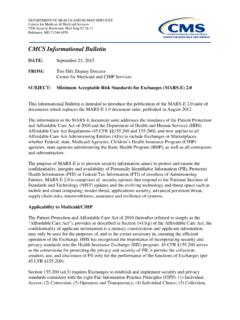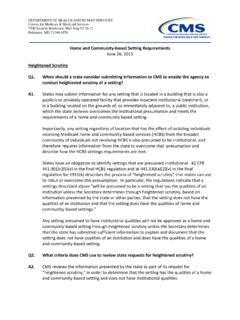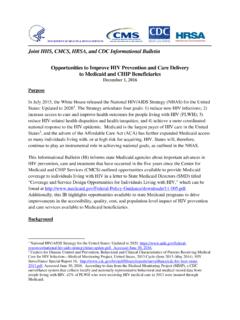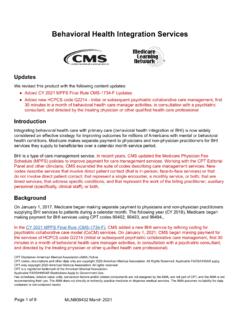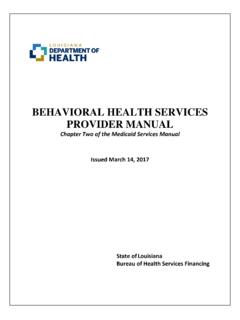Transcription of The Collaborative Care Model: An Approach for ... - Medicaid
1 health HOME Information Resource Center BRIEF- MAY 2013 This briefwas developed for the Centers for Medicare & Medicaid Services by the Center for health Care Strategies and Mathematica Policy Research. For more information or technical assistance in developing health homes, The Collaborative Care Model: An Approach for Integrating Physical and Mental health Care in Medicaid health Homes Executive Summary Depression and other common mental disorders are common, disabling, and associated with high health care costs and substantial losses in productivity,yet only about 25 percent of patients with these disorders receive effective care.
2 Only 20 percent of adult patients with mental health disorders are seen by mental health specialists and many prefer and receive treatment in primary care settings. Individuals with serious and persistent mental illnessesare more likely to be seen by specialty mental health providers, but they have limited access to effective medical care and high mortality rates,underscoring the need for better connections across primary care and mental health . The Collaborative care model is an evidence-based Approach for integratingphysical and behavioral health services that can be implemented within a primary care-based Medicaid health home model, among other settings.
3 Collaborative care includes: (1) care coordination and care management; (2) regular/proactive monitoring and treatment to target using validated clinical rating scales; and (3) regular, systematic psychiatric caseload reviews s d health itated, case-rate payments, or pay-for-performance mechanisms may provide ubstantially improve medical and mental health outcomes and functioning, as well as reduce health care consultation for patients who do not show clinical improvement. More than 70 randomized controlled trials have shown Collaborative care for common mental disorders such adepression to be more effective and cost-effective than usual care, across diverse practice settings and patient populations.
4 Collaborative care programs have been implemented by large health care organizations anplans in both commercially insured and low income/safety-net fee-for-service reimbursement programs have been a barrier to widespread implementation of Collaborative care, but new reimbursement models using capopportunities to expand its use. Implementation of evidence-based Collaborative care in Medicaid and in integrated care programs for individuals dually eligible for Medicare and Medicaid could s By J rgen Un tzer, MD, MPH, University of Washington; Henry Harbin, MD, health Care Consultant and former CEO of Magellan health Services; Michael Schoenbaum, PhD, National Institute of Mental health .
5 And Benjamin Druss, MD, MPH, Emory University IN BRIEF The integration of physical and mental health care is an important aspect of the Medicaid health home model. Collaborative care programs are one Approach to integration in which primary care providers, care managers, and psychiatric consultants work together to provide care and monitor patients progress. These programs have been shown to be both clinically-effective and cost-effective for a variety of mental health conditions, in a variety of settings, using several different payment mechanisms.
6 This brief highlights the Collaborative care model as one Approach to implementing integrated care under the Medicaid health homes authority. tates are continuously looking for evidence-based approaches to improving the health care of high-need, high-cost Medicaid populations. Strategies to improve the integration of physical and behavioral health care are essential for such individuals with complex needs. Not only are effective integrated approaches needed, but also innovative payment models to cover the costs of care.
7 health homes are one mechanism that can be used both to integrate primary and mental health care and to pay for the essential components of enhanced care management and care coordination required for effective integration . Authorized by the Affordable Care Act of 2010 (ACA) section 2703, the Medicaid health Home State Plan Option provides a mechanism to coordinate the primary, acute, behavioral , and long-term and social service needs of targeted beneficiaries. States can link Medicaid beneficiaries who have at least two chronic conditions, have one chronic condition and are at risk for another, or have a serious mental illness to ahealth home to coordinate that person's health care.
8 Regardless of the conditions targeted by the health home, the associated providers must meet all federal and state qualifications to serve as health homes, and must deliver a defined set of services (as further delineated in the section Payment Models for Collaborative Care). Across these services, a key desired outcome of the health home model is improved integration of primary and behavioral health care delivery. This brief highlights the Collaborative care model as one Approach to implementing integrated care under the health homes authority.
9 Future briefs from the health Home Information Resource Center will highlight other evidence-based or otherwise promising models worthy of consideration for promoting integrated care. Although the model is flexible enough to support a variety of chronic conditions, the Collaborative care model is more often utilized in a primary care-based Approach than within the specialty mental health care delivery system. behavioral health Services in Primary Care behavioral health problems such as depression, anxiety, alcohol or substance abuse are among the most common and disabling health conditions worldwide.
10 They often co-occur with chronic medical diseases and can substantially worsen associated health of depression have been estimated to be 20 percent in Medicaid populationsand 23 percent in the population eligible for both Medicare and When behavioral health problems are not effectively treated, they can impair self-care and adherence to medical and mental health treatments and they are associated with poor health outcomes and increased mortality. They are also associated with decreased work productivity3 , 4 and substantial increases in overall health care costs.




